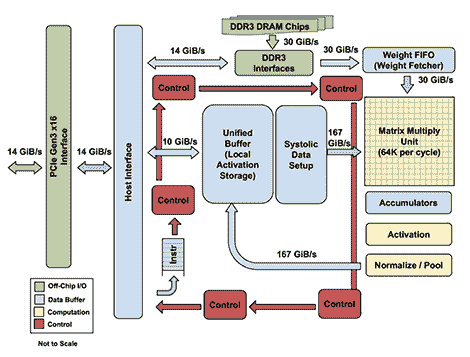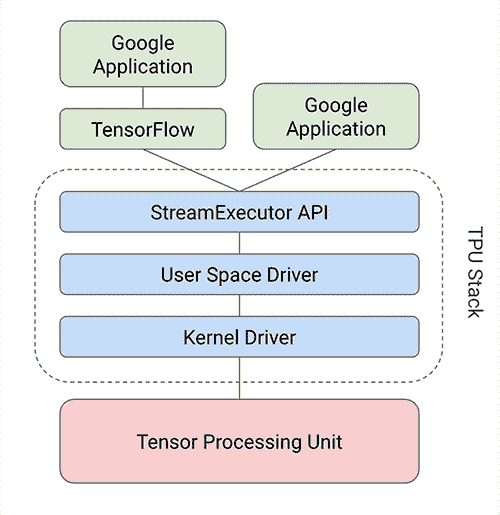张量处理单元
张量处理单元( TPU )是专用集成电路( ASIC ),它实现了针对计算要求而优化的硬件电路深度神经网络。 TPU 基于复杂指令集计算机( CISC )指令集,该指令集实现用于训练深度神经网络的复杂任务的高级指令。 TPU 架构的核心在于优化矩阵运算的脉动数组。
 The Architecture of TPUImage from: https://cloud.google.com/blog/big-data/2017/05/images/149454602921110/tpu-15.png
The Architecture of TPUImage from: https://cloud.google.com/blog/big-data/2017/05/images/149454602921110/tpu-15.png
TensorFlow 提供了一个编译器和软件堆栈,可将 API 调用从 TensorFlow 图转换为 TPU 指令。以下框图描述了在 TPU 堆栈顶部运行的 TensorFlow 模型的体系结构:
 Image from: https://cloud.google.com/blog/big-data/2017/05/images/149454602921110/tpu-2.pngFor more information on the TPU architecture, read the blog at the following link: https://cloud.google.com/blog/big-data/2017/05/an-in-depth-look-at-googles-first-tensor-processing-unit-tpu.
Image from: https://cloud.google.com/blog/big-data/2017/05/images/149454602921110/tpu-2.pngFor more information on the TPU architecture, read the blog at the following link: https://cloud.google.com/blog/big-data/2017/05/an-in-depth-look-at-googles-first-tensor-processing-unit-tpu.
TPU 的 TensorFlow API 位于tf.contrib.tpu模块中。为了在 TPU 上构建模型,使用以下三个 TPU 特定的 TensorFlow 模块:
tpu_config:tpu_config模块允许您创建配置对象,其中包含有关将运行模型的主机的信息。tpu_estimator:tpu_estimator模块将估计器封装在[HTG2]类中。要在 TPU 上运行估计器,我们创建此类的对象。tpu_optimizer:tpu_optimizer模块包装优化器。例如,在下面的示例代码中,我们将tpu_optimizer类中的 SGD 优化器包装在tpu_optimizer类中。
例如,以下代码使用 TF Estimator API 为 TPU 上的 MNIST 数据集构建 CNN 模型:
以下代码改编自 https://github.com/tensorflow/tpu-demos/blob/master/cloud_tpu/models/mnist/mnist.py.
import tensorflow as tf
from tensorflow.contrib.tpu.python.tpu import tpu_config
from tensorflow.contrib.tpu.python.tpu import tpu_estimator
from tensorflow.contrib.tpu.python.tpu import tpu_optimizer
learning_rate = 0.01
batch_size = 128
def metric_fn(labels, logits):
predictions = tf.argmax(logits, 1)
return {
"accuracy": tf.metrics.precision(
labels=labels, predictions=predictions),
}
def model_fn(features, labels, mode):
if mode == tf.estimator.ModeKeys.PREDICT:
raise RuntimeError("mode {} is not supported yet".format(mode))
input_layer = tf.reshape(features, [-1, 28, 28, 1])
conv1 = tf.layers.conv2d(
inputs=input_layer,
filters=32,
kernel_size=[5, 5],
padding="same",
activation=tf.nn.relu)
pool1 = tf.layers.max_pooling2d(inputs=conv1, pool_size=[2, 2],
strides=2)
conv2 = tf.layers.conv2d(
inputs=pool1,
filters=64,
kernel_size=[5, 5],
padding="same",
activation=tf.nn.relu)
pool2 = tf.layers.max_pooling2d(inputs=conv2, pool_size=[2, 2],
strides=2)
pool2_flat = tf.reshape(pool2, [-1, 7 * 7 * 64])
dense = tf.layers.dense(inputs=pool2_flat, units=128,
activation=tf.nn.relu)
dropout = tf.layers.dropout(
inputs=dense, rate=0.4,
training=mode == tf.estimator.ModeKeys.TRAIN)
logits = tf.layers.dense(inputs=dropout, units=10)
onehot_labels = tf.one_hot(indices=tf.cast(labels, tf.int32), depth=10)
loss = tf.losses.softmax_cross_entropy(
onehot_labels=onehot_labels, logits=logits)
if mode == tf.estimator.ModeKeys.EVAL:
return tpu_estimator.TPUEstimatorSpec(
mode=mode,
loss=loss,
eval_metrics=(metric_fn, [labels, logits]))
# Train.
decaying_learning_rate = tf.train.exponential_decay(learning_rate,
tf.train.get_global_step(),
100000,0.96)
optimizer = tpu_optimizer.CrossShardOptimizer(
tf.train.GradientDescentOptimizer(
learning_rate=decaying_learning_rate))
train_op = optimizer.minimize(loss,
global_step=tf.train.get_global_step())
return tpu_estimator.TPUEstimatorSpec(mode=mode,
loss=loss, train_op=train_op)
def get_input_fn(filename):
def input_fn(params):
batch_size = params["batch_size"]
def parser(serialized_example):
features = tf.parse_single_example(
serialized_example,
features={
"image_raw": tf.FixedLenFeature([], tf.string),
"label": tf.FixedLenFeature([], tf.int64),
})
image = tf.decode_raw(features["image_raw"], tf.uint8)
image.set_shape([28 * 28])
image = tf.cast(image, tf.float32) * (1\. / 255) - 0.5
label = tf.cast(features["label"], tf.int32)
return image, label
dataset = tf.data.TFRecordDataset(
filename, buffer_size=FLAGS.dataset_reader_buffer_size)
dataset = dataset.map(parser).cache().repeat()
dataset = dataset.apply(
tf.contrib.data.batch_and_drop_remainder(batch_size))
images, labels = dataset.make_one_shot_iterator().get_next()
return images, labels
return input_fn
# TPU config
master = 'local' #URL of the TPU instance
model_dir = '/home/armando/models/mnist'
n_iterations = 50 # number of iterations per TPU training loop
n_shards = 8 # number of TPU chips
run_config = tpu_config.RunConfig(
master=master,
evaluation_master=master,
model_dir=model_dir,
session_config=tf.ConfigProto(
allow_soft_placement=True,
log_device_placement=True
),
tpu_config=tpu_config.TPUConfig(n_iterations,
n_shards
)
)
estimator = tpu_estimator.TPUEstimator(
model_fn=model_fn,
use_tpu=True,
train_batch_size=batch_size,
eval_batch_size=batch_size,
config=run_config)
train_file = '/home/armando/datasets/mnist/train' # input data file
train_steps = 1000 # number of steps to train for
estimator.train(input_fn=get_input_fn(train_file),
max_steps=train_steps
)
eval_file = '/home/armando/datasets/mnist/test' # test data file
eval_steps = 10
estimator.evaluate(input_fn=get_input_fn(eval_file),
steps=eval_steps
)
有关在 TPU 上构建模型的更多示例,请访问以下链接:https://github.com/tensorflow/tpu-demos.